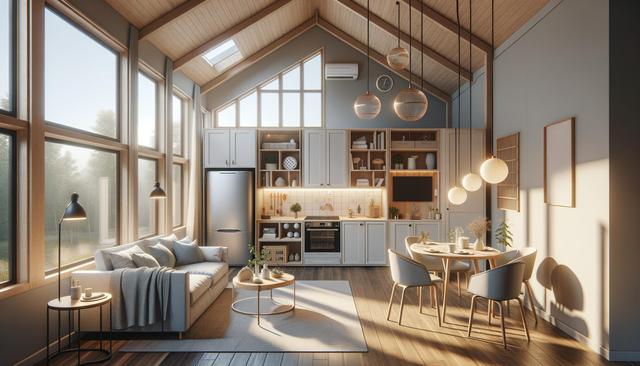Designing the Living Room for Comfort and Accessibility
The living room is often the central hub of any home, and for seniors, it should combine comfort, safety, and easy access. Modular homes allow for customized layouts, making it easier to incorporate age-friendly features from the start. Wider doorways and open floor plans are common choices that improve mobility, especially for those using walkers or wheelchairs. Flooring should be slip-resistant, with minimal transitions between rooms to reduce tripping hazards.
Comfortable seating with firm cushions and armrests makes it easier for seniors to sit down and stand up. Strategically placed outlets and smart lighting systems can also enhance daily living by reducing the need to move around excessively. Many modular home designs for seniors include built-in shelving and storage at accessible heights, eliminating the need for step stools or bending down frequently.
- Non-slip flooring materials like cork or rubber
- Furniture with ergonomic support
- Smart lighting with motion sensors
- Lowered shelving and accessible storage
These thoughtful details support a safe and enjoyable social environment, encouraging seniors to remain engaged and connected in their everyday lives.
Bedroom Features That Prioritize Rest and Independence
The bedroom in a senior-friendly modular home should be a peaceful retreat that promotes rest and supports physical needs. A single-level floor plan is ideal, with bedrooms placed strategically to minimize walking distance from the main living areas. Adjustable beds can be paired with bedside controls for lighting and climate, giving seniors more autonomy and comfort.
Closet space should be reimagined to include pull-down rods and slide-out drawers for easier access. Additionally, including a sitting area or a reading nook within the bedroom can provide a quiet space for relaxation without needing to move to another part of the home.
- Easy-to-reach closets and drawers
- Temperature controls within arm’s reach
- Nightlights or pathway lights for nighttime navigation
- Emergency alert systems integrated into the room
These adaptations help ensure that the bedroom remains a safe and restful space that supports the health and well-being of older adults.
Bathroom Safety and Smart Layout Choices
Bathrooms can pose some of the highest safety risks for seniors, but modular design makes it easier to address these concerns from the beginning. Walk-in showers with benches, handheld showerheads, and grab bars are essential features. Non-slip tiles and curbless shower entries further reduce the risk of falls.
Modular homes can also incorporate wider doorways and turning radius space for mobility aids. Vanity areas should include lever-handle faucets and lower counters, enabling use from a seated position if needed. Some designs even feature emergency call buttons or pull cords that connect to in-home monitoring systems.
- Grab bars in showers and near toilets
- Walk-in tubs or barrier-free showers
- Raised toilet seats with safety rails
- Anti-scald devices on faucets
By integrating these elements into the initial build, modular homes offer seniors a bathroom that is both functional and secure, reducing the likelihood of accidents while maintaining privacy and independence.
Kitchen Layouts That Support Independent Living
The kitchen in a senior-friendly modular home must strike a balance between utility and accessibility. Lower countertops, pull-out shelves, and appliances with front-mounted controls are common modifications. These features enable seniors to prepare meals with minimal strain and maximum safety.
A well-designed kitchen will also incorporate plenty of natural lighting, clear pathways, and easy-to-clean surfaces. Touchless faucets and induction cooktops can add layers of safety by minimizing the risk of burns or accidents. Modular homes allow for personalized kitchen designs that fit the mobility and lifestyle needs of the resident.
- Accessible cabinetry with pull-down racks
- Appliances with easy-to-read controls
- Anti-fatigue mats in standing areas
- Bright, glare-free lighting
These thoughtful touches not only make cooking more enjoyable but also help seniors maintain their nutritional independence, a key component of healthy aging.
Flexible Bonus Spaces for Hobbies and Care
One of the benefits of modular housing is the ability to include flexible rooms that can serve multiple purposes. For seniors, these might include spaces for hobbies, visiting caregivers, or even future medical needs. These rooms can be adapted over time as needs evolve, making the home more sustainable for long-term living.
Whether it’s a craft room, a home office, or an exercise area, having a designated space can support mental stimulation and physical activity. Some homeowners may choose to include a guest suite for visiting family members or part-time caregivers. Modular homes also make it easier to integrate smart home technologies that allow for remote monitoring or emergency response systems.
- Multi-use rooms for hobbies or therapy
- Convertible guest rooms with private bathrooms
- Built-in desk spaces for communication or telehealth
- Optional upgrades for future medical equipment
These adaptable rooms add value to the living experience, enabling seniors to enjoy their interests and manage their health within the comfort of their home.
Conclusion: Creating Comfortable, Adaptable Homes for Aging in Place
Modular homes offer a practical and customizable solution for seniors who wish to age in place. By focusing on room-by-room functionality — from accessible living rooms to safety-enhanced bathrooms — these homes provide a supportive environment that evolves with changing needs. With thoughtful design elements and flexible spaces, modular homes help seniors maintain their independence, safety, and quality of life, making them a valuable option for long-term living.






